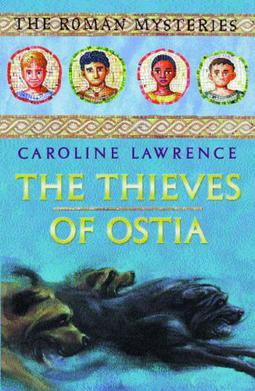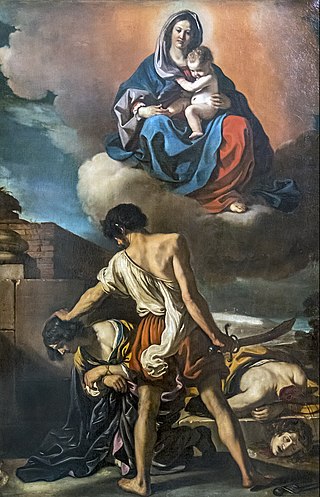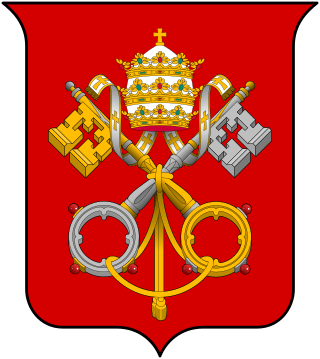The 380s decade ran from January 1, 380, to December 31, 389.
The 450s decade ran from January 1, 450, to December 31, 459.
The 330s decade ran from January 1, 330, to December 31, 339.

Ostia Antica was an ancient Roman city and the port of Rome located at the mouth of the Tiber River. It is near modern Ostia, 25 kilometres southwest of Rome. Due to silting and the invasion of sand, the site now lies 3 km (2 mi) from the sea. The name Ostia derives from Latin os 'mouth'.

The Donation of Constantine is a forged Roman imperial decree by which the 4th-century emperor Constantine the Great supposedly transferred authority over Rome and the western part of the Roman Empire to the Pope. Composed probably in the 8th century, it was used, especially in the 13th century, in support of claims of political authority by the papacy.

The Roman Mysteries is a series of historical novels for children by Caroline Lawrence. The first book, The Thieves of Ostia, was published in 2001, finishing with The Man from Pomegranate Street, published in 2009, and totaling 17 novels, plus a number of "mini-mysteries", spinoffs, and companion titles.

During the reign of the Roman Emperor Constantine the Great, Christianity began to transition to the dominant religion of the Roman Empire. Historians remain uncertain about Constantine's reasons for favoring Christianity, and theologians and historians have often argued about which form of early Christianity he subscribed to. There is no consensus among scholars as to whether he adopted his mother Helena's Christianity in his youth, or, as claimed by Eusebius of Caesarea, encouraged her to convert to the faith he had adopted.

Rechiar or Flavius Rechiarius was the third Suevic king of Gallaecia, from 448 until his death, and also the first one to be born in Gallaecia. He was one of the most innovative and belligerent of the Suevi monarchs. Hydatius, the contemporary bishop and chronicler from Galicia who is the sole contemporary source for biographical details of Rechiar, established his reputation as that of a barbarian with little sense of Roman law, culture, or custom; accusations already discredited, but very common at that time.

Flavia Valeria Constantina, later known as Saint Constance, was the eldest daughter of Roman emperor Constantine the Great and his second wife Fausta, daughter of Emperor Maximian. Constantina may have received the title of Augusta by her father, and is venerated as a saint, having developed a medieval legend wildly at variance with what is known of her actual character.

John and Paul are saints who lived during the fourth century in the Roman Empire. They were martyred at Rome on 26 June. The year of their martyrdom is uncertain according to their Acts; it occurred under Julian the Apostate (361–3).
Gallicanus may refer to:

Ostia is a large neighbourhood in the X Municipio of the comune of Rome, Italy, near the ancient port of Rome, which is now a major archaeological site known as Ostia Antica. Ostia is also the only municipio or district of Rome on the Tyrrhenian Sea, and many Romans spend the summer holidays there.

The Diocese of Rome, also called the Vicariate of Rome, is a Latin diocese of the Catholic Church under the direct jurisdiction of the Pope, who is Bishop of Rome and hence the supreme pontiff and head of the worldwide Catholic Church. As the Holy See, the papacy is a sovereign entity with diplomatic relations, and civil jurisdiction over the Vatican City State located geographically within Rome. The Diocese of Rome is the metropolitan diocese of the Province of Rome, an ecclesiastical province in Italy. The first bishop of Rome was Saint Peter in the first century. The incumbent since 13 March 2013 is Pope Francis.
Quintus Flavius Maesius Egnatius LollianussignoMavortius was a politician of the Roman Empire.

Constantine the Great's (272–337) relationship with the four Bishops of Rome during his reign is an important component of the history of the Papacy, and more generally the history of the Catholic Church.
Ovinius Gallicanus was a senator of the Roman Empire, probably the first Christian Roman consul.
Saint Gallicanus was a Roman martyr in Egypt in 363 AD, during the reign of Julian. According to his "Acta", he was a distinguished general in the war against the Persians. He was also consul with Symmachus in 330 and perhaps also once before with Caesonius Bassus in 317. After his conversion to Christianity he retired to Ostia, founded a hospital where he worked with Saint Hilarinus and endowed a church built by Constantine I. Under Julian he was banished to Egypt, and lived with the hermits in the desert. A small church was built in his honour in the Trastevere of Rome. His relics are at Rome in the church of Sant'Andrea della Valle. The legend of his conversion was dramatized in the tenth century by the nun Roswitha. He is commemorated on 25 June.
The gens Opellia, also spelled Opelia and Opilia, was a minor family of imperial Rome, which briefly emerged from obscurity when Marcus Opellius Macrinus was proclaimed emperor following the murder of Caracalla in AD 217. The only members of this gens who appear in history are the emperor and his son, Marcus Opellius Diadumenianus, who ruled briefly as co-emperor in 218, but other Opellii are found in inscriptions, particularly from Dacia.
Titus Flavius Piso was a Roman eques who held at least two senior postings during the reign of the Emperors Marcus Aurelius and Commodus.
Hilarinus was a martyr who died with Donatus of Arezzo during the persecutions of the Roman Emperor Julian. His feast day is 16 July.